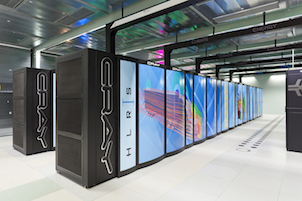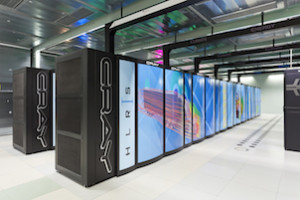HLRS in Stuttgart, Germany has upgraded their Hornet system to Hazel Hen, a 7.42 Petaflop Cray XC40 supercomputer. Twice as fast as its predecessor, Hazel Hen is now now ready to support European scientific and industrial users in their pursuit of R&D break-throughs.
In case you’re wondering, HRLS chose the name Hazel Hen because it’s the one animal that eats Hornets.
HLRS’s new Hazel Hen-system is powered by the latest Intel Xeon processor technologies and the CRAY Aries Interconnect technology leveraging the Dragonfly network topology. The installation encompasses 41 system cabinets hosting 7,712 compute notes with a total of 185,088 Intel Haswell E5-2680 v3 compute cores. Hazel Hen features 965 Terabyte of Main Memory and a total of 11 Petabyte of storage capacity spread over 32 additional cabinets hosting more than 8,300 disk drives which can be accessed with an input-/output rate of more than 350 Gigabyte per second.
As with its previous installation, HLRS had Hazel Hen put to the proof by challenging HPC users prior to declaring the system “up and running”. Scientists of the Institute of Aerodynamics (AIA) at the RWTH Aachen University leveraged HLRS’s new HPC platform for studies within the scope of the special research project (Sonderforschungsprojekt) SFB/TransRegio 129/Oxyflame which aims at reducing the emission of CO2 by conventional coal-fired power plants through oxy-fuel combustion. Simulating the heating processes of coal dust, the scientists aimed at gaining a better understanding about the conditions causing the carbon dust to ignite in an oxygen-carbon dioxide atmosphere. Calculations of such scenarios are extremely complex since carbon particles are of irregular, non-spherical shape which is why their motion is difficult to predict. Hazel Hen allows for the simulation of thousands of fully dissolved carbon particles moving freely in a turbulent flow. “Thanks to the computing capacities offered by Hazel Hen, we are able to execute calculations with particle numbers of a magnitude that up to now would have required several individual simulation steps,” explains principal investigator Dr. Matthias Meinke of the AIA.
Researchers of the Institute for Applied Materials (IAM) of the Karlsruhe Institute for Technology (KIT) and of the Institute of Materials and Processes (IMP) of the Karlsruhe University of Applied Sciences are leveraging the computing capacity of Hazel Hen for numerical simulations of solidification processes using the phase-field method. They simulated the ternary eutectic directional solidification of Al-Ag-Cu (Aluminum – Silver – Copper) in an area of 4116 x 4008 x 1000 cells with the aim to study the resulting patterns and the 3D-development of the micro structure. Using 171,696 compute cores of Hazel Hen, the researchers used the computing capacity of the new HLRS supercomputer almost to its full extent. Ternary super-alloys with defined properties for high-performance materials are e.g. of growing importance in the aerospace industry. A solid understanding of the material- and process parameters of the solidifying process is thus indispensable for which simulations like the ones executed on Hazel Hen provide valuable insight.
With Hazel Hen, we again are in the favorable position of being able to offer our users a state-of-the-art HPC system that meets their requirements,” explains Professor Dr.-Ing. Michael M. Resch, Director of the HLRS. “The first user projects already did deliver outstanding results and we are confident for Hazel Hen to achieve further simulation high- lights in the future.”
With the installation of Hazel Hen, HLRS completed the last step of its system roadmap as defined with the current purchasing plan by the German Federal Ministry of Education and Research and the federal states of Baden-Württemberg, Bavaria and North Rhine- Westphalia. This purchasing plan specified the step-by-step installation and expansion of Tier-0 HPC systems at the three national German high-performance computing centres in Stuttgart (HLRS), Garching near Munich (Leibniz Supercomputing Centre/LRZ) and in Jülich (Jülich Supercomputing Centre/JSC) to ensure Germany’s competitiveness in the global HPC arena.





